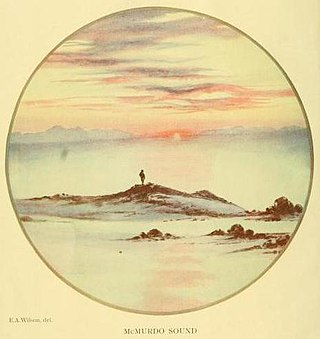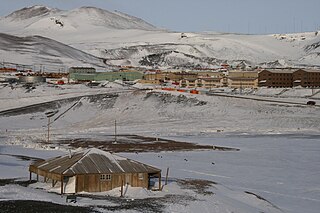
Ross Island is an island in Antarctica lying on the east side of McMurdo Sound and extending 43 nautical miles from Cape Bird in the north to Cape Armitage in the south, and a similar distance from Cape Royds in the west to Cape Crozier in the east. The island is entirely volcanic. Mount Erebus, 3,795 metres (12,451 ft), near the center, is an active volcano. Mount Terror, 3,230 metres (10,600 ft) about 20 nautical miles eastward, is an extinct volcano. Mount Bird rises to 1,765 metres (5,791 ft) just south of Cape Bird. Ross Island lies within the boundary of Ross Dependency, an area of Antarctica claimed by New Zealand.

Edward Adrian Wilson was an English polar explorer, ornithologist, natural historian, physician and artist.

Framheim was the name of explorer Roald Amundsen's base at the Bay of Whales on the Ross Ice Shelf in Antarctica during his successful quest for the South Pole. It was used between January 1911 and February 1912.
Hope Bay is a bay 3 nautical miles long and 2 nautical miles wide, indenting the tip of the Antarctic Peninsula and opening on Antarctic Sound.

Terra Nova Bay is a bay which is often ice free, about 40 nautical miles long, lying between Cape Washington and the Drygalski Ice Tongue along the coast of Victoria Land, Antarctica. It was discovered by the British National Antarctic Expedition under Robert Falcon Scott, 1901–1904, and named by him after Terra Nova, one of the relief ships for the expedition.

Thomas Crean was an Irish seaman and Antarctic explorer who was awarded the Albert Medal for Lifesaving (AM).

Scott's Hut is a building located on the north shore of Cape Evans on Ross Island in Antarctica. It was erected in 1911 by the British Antarctic Expedition of 1910–1913 led by Robert Falcon Scott.

The Terra NovaExpedition, officially the British Antarctic Expedition, was an expedition to Antarctica which took place between 1910 and 1913. Led by Captain Robert Falcon Scott, the expedition had various scientific and geographical objectives. Scott wished to continue the scientific work that he had begun when leading the Discovery Expedition from 1901 to 1904, and wanted to be the first to reach the geographic South Pole.

George Murray Levick was a British Antarctic explorer, naval surgeon and founder of the Public Schools Exploring Society.

The Worst Journey in the World is a 1922 memoir by Apsley Cherry-Garrard of Robert Falcon Scott's Terra Nova expedition to the South Pole in 1910–1913. It has earned wide praise for its frank treatment of the difficulties of the expedition, the causes of its disastrous outcome, and the meaning of human suffering under extreme conditions.
Victor Lindsey Arbuthnot Campbell was an English Royal Navy officer and Antarctic explorer.

Cape Adare is a prominent cape of black basalt forming the northern tip of the Adare Peninsula and the north-easternmost extremity of Victoria Land, East Antarctica.
Sir Raymond Edward Priestley was an English geologist and early Antarctic explorer. He was Vice-Chancellor of the University of Birmingham, where he helped found The Raymond Priestley Centre on the shores of Coniston Water in the Lake District National Park.

The drift of the Antarctic exploration vessel SY Aurora was an ordeal which lasted 312 days, affecting the Ross Sea party of Sir Ernest Shackleton's Imperial Trans-Antarctic Expedition, 1914–1917. It began when the ship broke loose from its anchorage in McMurdo Sound in May 1915, during a gale. Caught in heavy pack ice and unable to manoeuvre, Aurora, with eighteen men aboard, was carried into the open waters of the Ross Sea and Southern Ocean, leaving ten men stranded ashore with meagre provisions.

Discovery Hut was built by Robert Falcon Scott during the Discovery Expedition of 1901–1904 in 1902 and is located at Hut Point on Ross Island by McMurdo Sound, Antarctica. Visitors to Antarctica, arriving at either the US Base at McMurdo or New Zealand's Scott Base are likely to encounter Discovery Hut as both are located on Hut Point. Discovery Hut is just 300m from McMurdo Base. The hut has been designated a Historic Site or Monument, following a proposal by New Zealand and the United Kingdom to the Antarctic Treaty Consultative Meeting.
Northern Foothills is a line of coastal hills on the west side of Terra Nova Bay, Victoria Land, Antarctica, lying southward of Browning Pass and forming a peninsular continuation of the Deep Freeze Range. It was named by the Northern Party of the British Antarctic Expedition, 1910–13 (BrAE), because during field operations Inexpressible Island, close southward, was originally referred to as the "Southern Foothills."
Hells Gate Moraine is a glacial moraine at the head of Evans Cove on the coast of Victoria Land, Antarctica. It extends southward to Hells Gate from nearby Vegetation Island and Cape Confusion.
Frank V. Browning (1882–1930) was a native of Devonshire and explorer of Antarctica. He was part of the Terra Nova Expedition of 1910–1913. In this service he was one of the castaways of the Northern Party that was marooned overwinter on Victoria Land in 1912.

Qinling Station is an Antarctic research station operated by the Polar Research Institute of China. It is situated on the southern edge of Inexpressible Island in Terra Nova Bay, Scott Coast, Victoria Land, on the Ross Sea coast of East Antarctica.

Sledging rations are a type of meal consumed by members of polar expeditions. These rations are designed for the use of sledging parties travelling long distances without support vehicles. They are meant to be calorically dense and provide a balanced diet. They must optimize weight and portability, as well as nutritional benefit. Typically, sledging rations are dehydrated to cut down on weight.

















